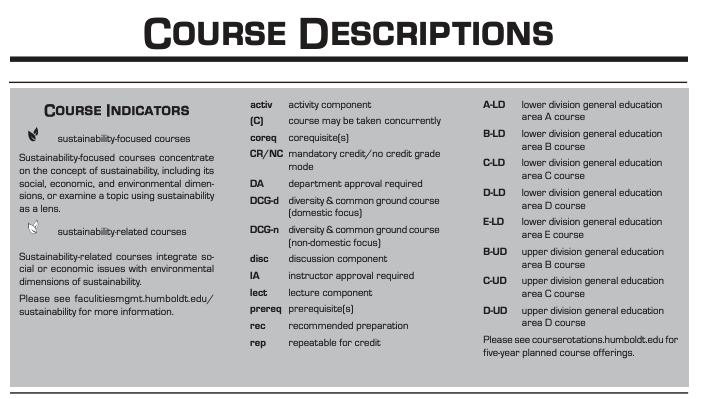This is an optional Innovation & Leadership credit. These credits recognize exemplary practices and performance above and beyond what is recognized in standard credits and may not be relevant to every institution. Scoring in the Innovation and Leadership section is capped at 4 bonus points total.
Credit Language
IN 38: Sustainability Course Designation – version 2.2
Frequently Asked Questions
What are some examples of ways that sustainability courses can be designated in a course catalog?
For an online catalog, a sustainability “filter” is most commonly used to highlight courses with sustainability designations. For a printed catalog, a sustainability “tag” such as an image or abbreviation is displayed next to courses that are designated.
Example Responses
- Cascadia College – Provides comprehensive documentation in the form of a printed and an online catalog.
- Florida Gulf Coast University – Good example of applying a sustainability filter in an online course catalog. Very clear instructions for navigating to sustainability courses.
- HEC Montréal – Includes clear instructions and a link to an easy-to-navigate online course directory.
- Cal Poly Humboldt – Demonstrates how a “tag” in a printed catalog fulfills the requirements of this credit (see screenshot of Course Descriptions from printed catalog page below).
- Santa Clara University – Comprehensive documentation. Includes screenshot of course catalog with Sustainability filter.
- University of Rochester – The Notes field includes a link to the online catalog and clear instructions for accessing sustainability courses.
- Virginia Commonwealth University – Links directly to a public course catalog and provides step-by-step instructions on how to find the sustainability designated courses.

Common Issues Identified During Review
- Intent of this exemplary practice is to recognize institutions that go above and beyond the AC 1 criteria by designating sustainability courses across multiple departments. This generally involves identifying symbol or code to help students distinguish sustainability courses from other courses (e.g., a sustainability “filter” in an online catalog or a sustainability “tag” in a printed catalog). Providing a website that lists sustainability courses or identifying courses offered by a sustainability-focused academic unit is not sufficient in the absence of course-level designations that encompass courses offered by multiple departments.
